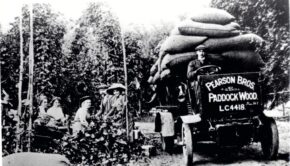Local History: William Arnold, Speeding and the Model T Ford
By the time you read this the first Speed Watch Conference in Kent will have taken place at the Kent Police College in Maidstone. It is interesting to reflect that the issue of speed on the roads began over 100 years ago.
From the 1890s cars began to have a significant effect. Horses had been a principle means of transport but now they would be replaced.
Infrastructure of roads and pavements were not in place however and naturally with such dramatic changes came serious concerns about the need to prevent ‘reckless behaviour’.
A need to review existing law was recognised (although frightening horses was forbidden!)
In 1895 the first motoring offence was registered and the first speeding fine in the country happened in Paddock Wood on 28th January 1896.
William Arnold of East Peckham is said to have owned the first car in Kent. This was a ‘Benz’ imported from Germany. The car was used as a pattern to build other vehicles.
William, perhaps to be regarded as the ‘boy racer’ of the time, was spotted by a police constable speeding at 8 mph exceeding the 2mph speed limit by a considerable margin. After a high speed five mile chase on his bicycle which apparently lasted for half an hour, the constable apprehended the culprit and the offending vehicle was brought to a halt.
William Arnold was prosecuted by Magistrates at Tonbridge for operating a car without
“at least three persons to conduct the car one of them preceding the same by at least 20 yards carrying a red flag…..and at a speed no greater than two miles an hour and not having the name and residence of the owner displayed”
He pleaded guilty and as John Moon records (Collected Lamberhurst Essays, 2003) Arnold tried to argue that his car was outside of the scope of the law. It seemed reasonable as The Red Flag Act of 1865 really related to steam driven traction engines. Having refused the option of seven days hard labour, which seems a little harsh compared to the options for offending motorists today, William paid a fine of £4 7s (four pounds seven shillings) approximately £200 in today’s money.
And so it came to be in 1895 the first motoring offence was registered; the following year the first pedestrian was killed by a horseless carriage. In 1898 the first driver, at the controls of a vehicle doing the reckless speed of 17mph, was also killed.
Motor car enthusiasts across the country were keen for the removal of these restrictions. The Mayor of Tunbridge Wells, Sir David Salomons 1st Baronet (22 November 1797 – 18 July 1873), organized the first automobile exhibition to be held on 15th October 1895 in his local agricultural society’s showground.
The Locomotives on Highways Act 1896 removed strict rules and speed limits in UK that were included in the earlier Acts . It came into operation on November 14, 1896.
The speed limit was raised to 20 mph by the Motor Car Act 1903. Both the Locomotives on Highways Act 1896 and the Motor Car Act 1903 were repealed by the Road Traffic Act 1930.
1908 was a historic year when the automobile became popular largely due to the production of what was to become as the most influential car of the 20th century the Model T Ford.
It was produced by Henry Ford ‘s Motor Company from September 1908 to October 1927 and is regarded as the first affordable car.
The Model T was a great commercial success, Over 15 million were manufactured, reaching a rate of 9,000 to 10,000 cars a day in 1925 more than any other model of its day.
“I will build a car for the great multitude. It will be large enough for the family, but small enough for the individual to run and care for. It will be constructed of the best materials, by the best men to be hired, after the simplest designs that modern engineering can devise. But it will be so low in price that no man making a good salary will be unable to own one – and enjoy with his family the blessing of hours of pleasure in God’s great open spaces.”
In the early days Commercial travellers came off the trains at Paddock Wood and engaged taxis to travel round to the shops to sell their wares.
Model T Fords were stored in the market hall throughout the year for that purpose, except for when the annual fat stock show was held there. During the late 1920s a young lad was filling one with fuel. His friend held a lamp too close and the fuel in the tank started to glow. He quickly stuffed a rag in the hole and sat on it. They were both very lucky to survive, along with the market hall.
The Model T had four cylinder engines, producing 20 hp (15 kW) for a top speed of 40–45 mph (64–72 km/h). The engine was capable of running on gasoline, kerosene, or ethanol,
Driving a Model T might be a challenge for the modern motorist, more so perhaps for driving instructors.
The transmission was controlled with three foot pedals and a lever mounted on the side of the driver’s seat. The throttle (accelerator) worked from a lever on the steering wheel with no computer technology to assist! The left pedal engaged the gear. With the lower lever in either mid position or fully forward and the pedal pressed and held forward the car entered low gear. If held in a mid position the car remained in neutral at which point the middle pedal could be used to engage reverse gear.
The parking brake was activated by pulling the aforementioned lever all the way back. This doubled as an emergency brake. The transmission brake was operated by the right foot pedal. A band was applied around a drum in the transmission, and ideally prevented the rear wheels from turning.
If the driver took his foot off the left pedal, the Model T went into high gear, but only when the lever was fully forward. In any other position the pedal would only move up as far as the central neutral position which allowed the car to be held in neutral while the driver cranked the engine by hand.
Complicated? Of course not the car could cruise without the driver having to press any of the pedals. There was no separate clutch pedal to even worry about.
We can assume that help was readily available at the Love’s workshop premises in Commercial Road where during the 1920s, a manual petrol pump was installed at the entrance. The family also ran taxis. Given the location of Paddock Wood, this must have become a very useful business to serve the surrounding areas. Petrol was normally stored in tins in a pit covered with a steel plate
A second hand seven horse power Benz car was acquired by the Loves in 1907. We can only speculate whether it was bought from William Arnold, the first ‘boy racer’.






Comments